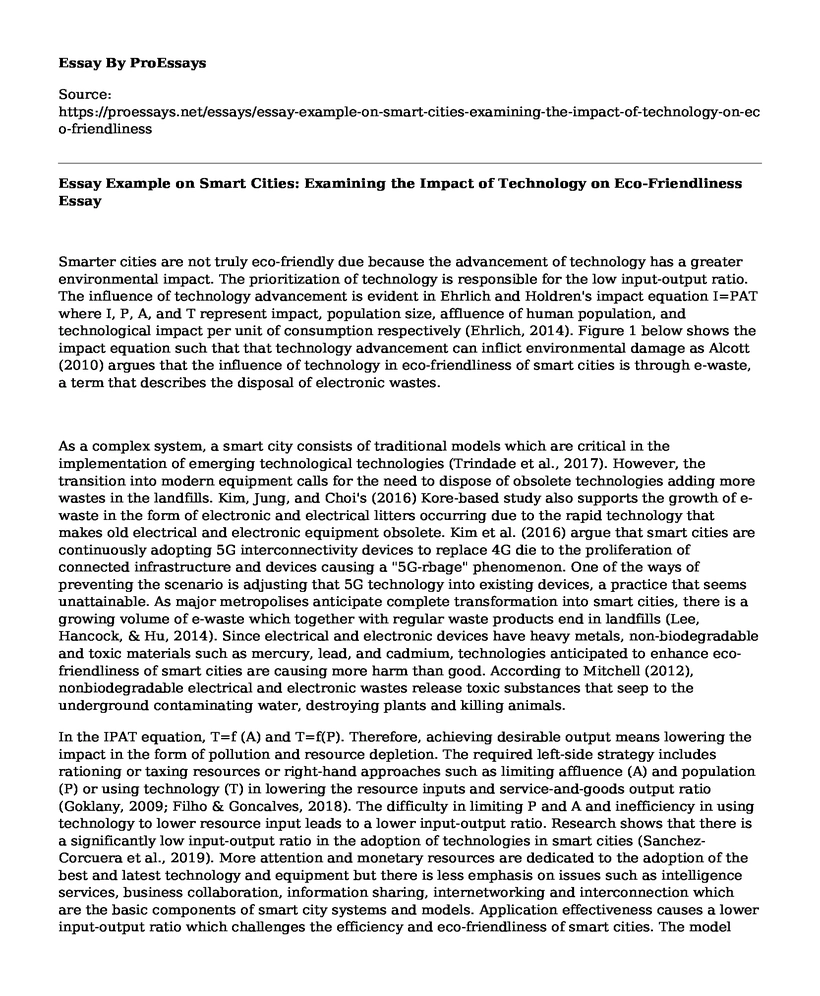Smarter cities are not truly eco-friendly due because the advancement of technology has a greater environmental impact. The prioritization of technology is responsible for the low input-output ratio. The influence of technology advancement is evident in Ehrlich and Holdren's impact equation I=PAT where I, P, A, and T represent impact, population size, affluence of human population, and technological impact per unit of consumption respectively (Ehrlich, 2014). Figure 1 below shows the impact equation such that that technology advancement can inflict environmental damage as Alcott (2010) argues that the influence of technology in eco-friendliness of smart cities is through e-waste, a term that describes the disposal of electronic wastes.
As a complex system, a smart city consists of traditional models which are critical in the implementation of emerging technological technologies (Trindade et al., 2017). However, the transition into modern equipment calls for the need to dispose of obsolete technologies adding more wastes in the landfills. Kim, Jung, and Choi's (2016) Kore-based study also supports the growth of e-waste in the form of electronic and electrical litters occurring due to the rapid technology that makes old electrical and electronic equipment obsolete. Kim et al. (2016) argue that smart cities are continuously adopting 5G interconnectivity devices to replace 4G die to the proliferation of connected infrastructure and devices causing a "5G-rbage" phenomenon. One of the ways of preventing the scenario is adjusting that 5G technology into existing devices, a practice that seems unattainable. As major metropolises anticipate complete transformation into smart cities, there is a growing volume of e-waste which together with regular waste products end in landfills (Lee, Hancock, & Hu, 2014). Since electrical and electronic devices have heavy metals, non-biodegradable and toxic materials such as mercury, lead, and cadmium, technologies anticipated to enhance eco-friendliness of smart cities are causing more harm than good. According to Mitchell (2012), nonbiodegradable electrical and electronic wastes release toxic substances that seep to the underground contaminating water, destroying plants and killing animals.
In the IPAT equation, T=f (A) and T=f(P). Therefore, achieving desirable output means lowering the impact in the form of pollution and resource depletion. The required left-side strategy includes rationing or taxing resources or right-hand approaches such as limiting affluence (A) and population (P) or using technology (T) in lowering the resource inputs and service-and-goods output ratio (Goklany, 2009; Filho & Goncalves, 2018). The difficulty in limiting P and A and inefficiency in using technology to lower resource input leads to a lower input-output ratio. Research shows that there is a significantly low input-output ratio in the adoption of technologies in smart cities (Sanchez-Corcuera et al., 2019). More attention and monetary resources are dedicated to the adoption of the best and latest technology and equipment but there is less emphasis on issues such as intelligence services, business collaboration, information sharing, internetworking and interconnection which are the basic components of smart city systems and models. Application effectiveness causes a lower input-output ratio which challenges the efficiency and eco-friendliness of smart cities. The model and systems of internetworking and interconnection require smart cities to have private-public ecosystems that enable information sharing and collaboration for co-creating smart, creative and new solutions (Alcott, 2010; Lee, Hancock, & Hu, 2014). The need for interconnection, internetworking and collaboration to balance the input-output ratio follows Postranecky and Svitek's (2017) suggestion that successful creation of smart cities is a product of the partnership between different stakeholders who collaborates in different aspects to ensure that the environment is ready for implementation of technology. Users or citizens should occupy the center of the internetworking model to signify that an eco-friendly and successful smart city must be user-centric.
References
Alcott, B. (2010). Impact caps: why population, affluence and technology strategies should be abandoned. Journal of Cleaner Production, 18(6), 522-560.https://doi.org/10.1016/j.jclepro.2009.08.001.
Ehrlich, P. R. (2014). Human impact: the ethics of I=PAT. Ethics in Science and Environmental Politics, 14(1), 11-18.doi: 10.3354/esep00151.
Filho, B., & Goncalves, R. (2018). Measuring the impact of utility services for a Smart City infrastructure using an Input-Output approach. Journal of Physics: Conference Series, 1065(20), 202003.doi: 10.1088/1742-6596/1065/20/202003.
Goklany, I. M. (2009). Have increases in population, affluence and technology worsened human and environmental well-being? Electronic Journal of Sustainable Development, 1(3), 1-18.
Kim, K., Jung, J.-K., & Choi, J. (2016). Impact of the Smart City Industry on the Korean. Sustainability, 8, 649; doi:10.3390/su8070649 .
Lee, J., Hancock, M., & Hu, M. (2014). Towards an effective framework for building smart cities: Lessons from Seoul and San Francisco. Technology Forecast Sociology, 1(89), 80-99.
Mitchell, R. (2012). Technology Is Not Enough: Climate Change, Population, Affluence, and Consumption. Journal of Environment and Development, 21(1), 24-47.https://doi.org/10.1177/1070496511435670.
Postranecky, M., & Svitek, M. (2017). Conceptual Model of Complex Multi-agent System Smart City 4.0. In Industrial Applications of Holonic and Multi-Agent Systems (pp. DOI: 10.1007/978-3-319-64635-0_16). Prague: Springer International Publishing.
Sanchez-Corcuera et al. (2019). Smart cities survey: Technologies, application domains and challenges for the cities of the future. International Journal of Distributed Sensor Networks, 15(6), 1-9.https://doi.org/10.1177/1550147719853984.
Trindade et al. (2017). Sustainable development of smart cities: a systematic review of the literature. Journal of Open Innovation: Technology, Market, and Complexity, 3(11), 6-11.
Cite this page
Essay Example on Smart Cities: Examining the Impact of Technology on Eco-Friendliness. (2023, Mar 02). Retrieved from https://proessays.net/essays/essay-example-on-smart-cities-examining-the-impact-of-technology-on-eco-friendliness
If you are the original author of this essay and no longer wish to have it published on the ProEssays website, please click below to request its removal:
- Research Proposal on Impact of Artificial Intelligence on Audit Firms
- Community Nurse Extend to Disaster Management - Essay Sample
- Research Paper on AI in Pharma: Unlocking Scientific Breakthroughs Through Machine Learning
- Essay on Agriculture Adapts to Climate Change: Innovations and Technologies.
- Essay Example on Atterberg Limits: Shrinkage, Plastic & Liquid Limits
- Upgrading Markets: Changing Population Needs & Trends - Essay Sample
- Essay Example on Exploring the Depths of Robert Macfarlane's 'Underland': Red Dancers in Lofoten







